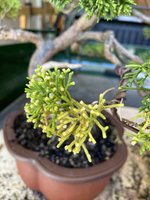Shamino
Yamadori
The photos below show three of my Junipers (Chinensis) and a Chinese Elm. This spring I repotted the second two junipers and the Elm with a new soil I obtained from a reputable dealer. I have always used an organic potting soil with no problems but the trees repotted in this soil are yellowing (the junipers) and have not leafed yet (the Elm). To treat the yellowing I have sprayed for mites ( Avid 0.15 SEC) and sprayed for juniper fungus (Phyto27), two problems I've had before and was able to correct. This time though, the two trees affected continue to get worse.
First, does anyone recognize this new soil of mine? You can see it well on the elm.
Second, would this soil require different watering than the previous organic soil? (I can't tell if I'm watering too much or too little...it's been fairly hot here in Maine and I've been watering every day.)
Third, any suggestions about what's going on here?
First, does anyone recognize this new soil of mine? You can see it well on the elm.
Second, would this soil require different watering than the previous organic soil? (I can't tell if I'm watering too much or too little...it's been fairly hot here in Maine and I've been watering every day.)
Third, any suggestions about what's going on here?








